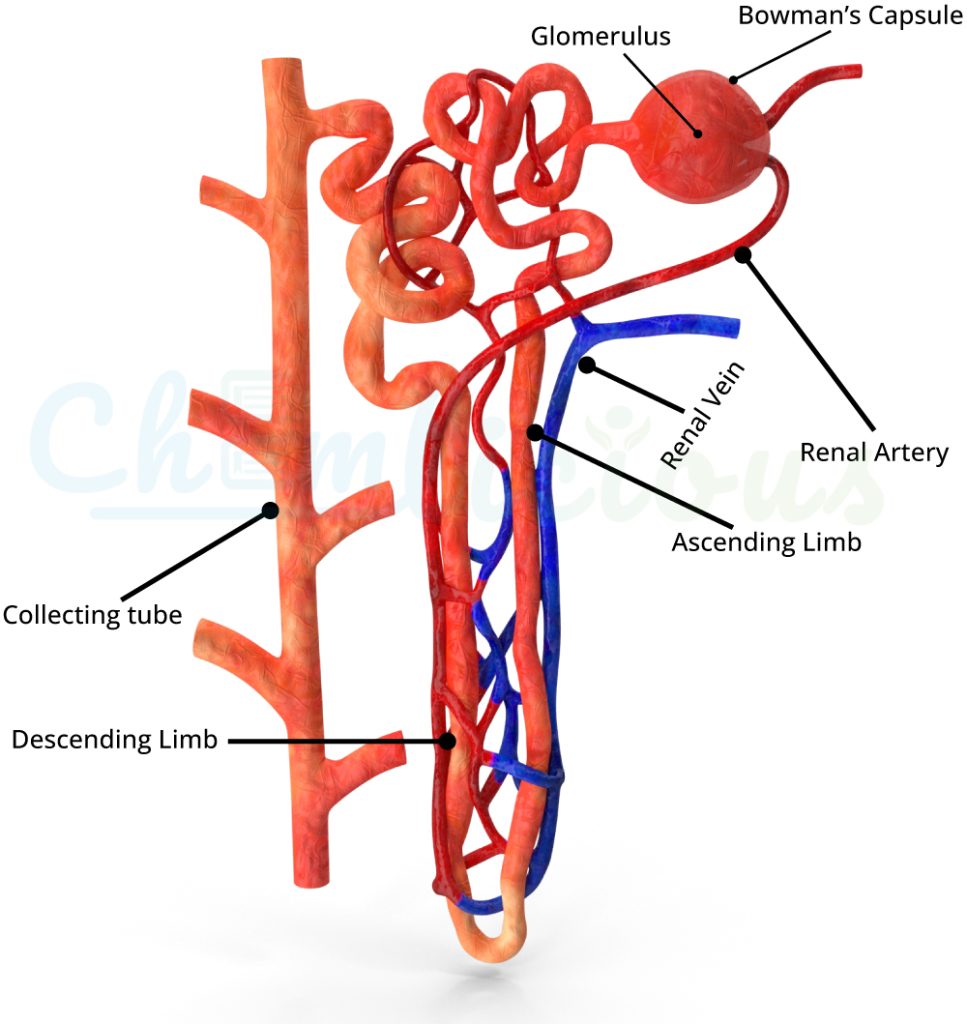The Functional Unit of the Kidney:
The functional unit of the kidney is the nephron. The kidneys are vital organs with multiple important functions. The kidneys filter waste, excess substances, and toxins from the blood. Kidneys turn these substances into urine. Our body then removes urine.
This article includes:
Structure & Labelled Diagram of Nephron
Where is the Nephron Located?
The nephron, the functional unit of the kidney, is located deep within the renal cortex and medulla of the kidney. Each kidney houses millions of nephrons, which are responsible for filtering the blood and producing urine.
Labelled Diagram of Nephron
To better understand the nephron, let’s take a closer look at its anatomy through a labelled diagram:

Fig: Nephron Diagram with labels
Now that we’ve got a visual aid, let’s break down the components of the nephron and their roles in the grand scheme of kidney function.
What is a Cortical Nephron?
The cortical nephron – one of the two main types of nephrons found in your kidneys. These little portions makeup around 85% of all nephrons and reside in the outer region of the kidney called the renal cortex. They play a important role in regulating the concentration of ions and water in your blood, ensuring your body maintains the perfect balance of fluids and electrolytes.
Components of Nephron
The nephron is the functional unit of the kidney that filters blood and makes urine. Nephron consist of different parts which work together to do the filtration and reabsorption process within the kidneys.
Glomerulus
The glomerulus is a small, round cluster of blood vessels inside the Bowman’s capsule at the beginning of the nephron. The blood filtration starts at glomerulus. During this process, blood pressure forces water, ions, and waste out of the bloodstream and into the Bowman’s capsule. This creates a fluid known as filtrate.
Bowman’s Capsule:
The Bowman’s capsule is a cup-shaped structure. It surrounds the glomerulus. The capsule collects the filtrate that comes out of the blood vessels. The capsule is where the nephron begins its journey, collecting the filtrate and directing it into the renal tubules.
Proximal Convoluted Tubule (PCT):
The filtrate exits the Bowman’s capsule and goes into the proximal convoluted tubule, which is a twisted part of the nephron. During this process, the bloodstream absorbs glucose, amino acids, and water. This prevents the loss of valuable nutrients in the urine.
Loop of Henle:
The fluid from the proximal convoluted tubule moves into the loop of Henle. The loop of Henle is a U-shaped structure. It reaches into the renal medulla. The loop of Henle is important in creating a concentration gradient in the kidney. This gradient allows for the reabsorption of water and the concentration of urine.
Distal Convoluted Tubule (DCT):
After leaving the loop of Henle, the filtrate enters the distal convoluted tubule, another twisted segment of the nephron located closer to the renal cortex. Here, additional fine-tuning of electrolyte balance occurs, with sodium, potassium, and hydrogen ions being exchanged to maintain proper pH and electrolyte levels in the body.
Collecting Duct:
Finally, the processed filtrate flows into the collecting duct, a tubular structure that gathers urine from multiple nephrons. As the urine passes through the collecting duct, its final composition is fine-tuned based on the body’s hydration status and electrolyte balance. Ultimately, the urine is transported to the renal pelvis, where it is moved into the ureter and eventually expelled from the body.
How Many Nephrons are in Each Kidney?
Have you ever wondered how many of these tiny filtration units are packed into your kidneys? Brace yourself for this mind-boggling fact: each kidney houses anywhere from one to two million nephrons! That’s right – millions of these microscopic structures working tirelessly to keep your blood clean and your body functioning optimally.
Importance of the Nephron
As we know that the functional unit of the kidney is the nephron. Now that we’ve revealed the inner workings of the nephron, it’s time to study the vital role it plays in keeping you healthy. The kidney’s nephron has important roles such as regulating blood pressure, maintaining electrolyte balance, and eliminating waste. Without these tiny filtration units, our bodies would struggle to maintain homeostasis, leading to a host of health issues.
So, the next time you take a sip of water or enjoy a hearty meal, take a moment to thank your nephrons for their hard work behind the scenes. The functional unit of the kidney is the nephron. After all, they’re the heroes keeping your body in perfect harmony.



